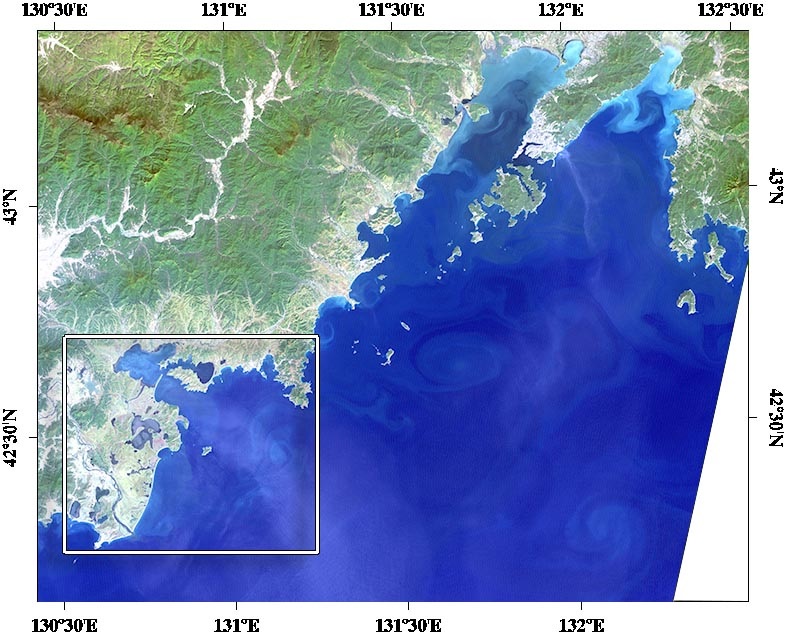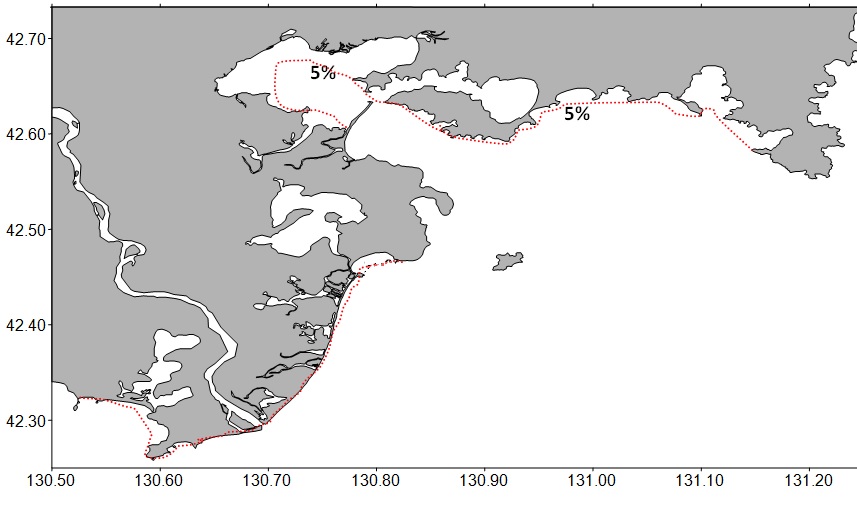BISAC NAT010000 Ecology
BISAC NAT045050 Ecosystems & Habitats / Coastal Regions & Shorelines
BISAC NAT025000 Ecosystems & Habitats / Oceans & Seas
BISAC NAT045030 Ecosystems & Habitats / Polar Regions
BISAC SCI081000 Earth Sciences / Hydrology
BISAC SCI092000 Global Warming & Climate Change
BISAC SCI020000 Life Sciences / Ecology
BISAC SCI039000 Life Sciences / Marine Biology
BISAC SOC053000 Regional Studies
BISAC TEC060000 Marine & Naval
On the basis of the object habitat analysis, on the created data archives of the hydrometeorological and hydrochemical limiting external environment parameters, by means of the reliability theory methodology and the probabilistic analysis, as well as the multidimensional statistics, the algorithm of the ecological substantiation of bio-productivity formation is formulated. On the basis of the above the algorithm of the spatial areas of Gracilaria verrucosa possible cultivation in Peter the Great Bay is estimated.
Peter the Great Bay, Gracilaria, admissible environmental risk
I. Introduction
The important component of planning the creation and development of aquaculture objects is the environmental risks assessment and the development of algorithms of ecological substantiation of biological efficiency formation; the latter based on the comprehensive information on existential variability of the environment limiting factors.
The purpose of the work is the development of algorithms and realization of a problem of an environmental risks assessment for a possibility of Gracilaria verrucosa cultivation substantiation in southwest part of Peter the Great Bay. This algae has an economic importance as an agarophyte. It has considerable growth rates (up to 8% a day), high concentration of agar (up to 57% based on its dry weight) and it has the best adaptive capacity in contrast with other species of Gracilaria. Observations have shown that the Gracilaria in the course of its growth can withstand very wide limits of salinity (3-33 ‰), temperatures (8-32°C), light intensity (0-400 Wm–2), concentration of ammonium ions (0.2-6•104 mkg • l-1) and pH index (6-9) [1-2].
On the basis of the object habitat analysis, on the created data archives of the hydrometeorological and hydrochemical limiting external environment parameters, by means of the reliability theory methodology and the probabilistic analysis, as well as the multidimensional statistics, the algorithm of the ecological substantiation of bio-productivity formation is formulated. On the basis of the above the algorithm of the spatial areas of Gracilaria verrucosa possible cultivation in Peter the Great Bay is estimated (Fig.1).
II. Data
The archive of abiotic factors values is based on the ship’s observations carried out in Peter the Great Bay in 1952-2009 [3]. Oceanographic data include measurements of water temperature and salinity, content of the dissolved oxygen, nitrates concentration, phosphates and

Fig.1. Landsat-7 image. Peter the Great Bay. Rectangle shows the area of investigation.
silicates, pH index. The ship’s observations were supplemented with the data on illumination and content of the dissolved inorganic carbon (DIC) which was determined by the ratio [4]

The analysis of the collected information shows the following:
Water temperature in Peter the Great Bay within a year changes from -1.85 in January-February up to 23-24 °C in July-September. The seasonal changes of water temperature in Peter the Great Bay mainly occur in surface layer up to 30-35 m deep. In lower layers the seasonal fluctuations of temperatures are not large. They are almost not felt at the depths more than 50-55 m.
The average salinity on the surface is 33-34 ‰. In shallow waters of the Bay salinity in January-February can increase up to 35-35,6 ‰ due to ice formation [3]. In summer in gulfs and bays under the influence of a river drain it can decrease to 27–29 ‰, and in the period of heavy rains – to smaller values.
The dissolved oxygen. According to the long-term data, from April to December in waters of Peter the Great Bay, the average monthly concentration of oxygen changes in the surface layer of water from 3.72 to 9:20 ml/l (73–129% of saturation), in the bottom layer – from 4.22 to 8.46 ml/l (70–127%). In distribution of oxygen two maxima are observed: in April and in November-December; the latter is connected with the intensification of photosynthesis. Minimum oxygen content is noted during the greatest warming up of waters, i.e. during the summer period.
The distribution of nutrients (nitrates, phosphates, silicates) in waters of Peter the Great Bay is heterogeneous. The continental drain (a source of phosphorus and silicon salts) has an impact on change of the reserves of nutritious salts in sea water. In general the Peter the Great Bay water mass is saturated with the organic substance. Due to the influence of the continental drain, the specific vertical distribution of biogeneous substances is observed: the surface layers are rich in nutrients, the more the depth the less the quantity. Commencing from 50 m horizon the quantity of nutrients increases due to the immersion of fossils and their decomposition due to high concentration of the dissolved oxygen.
Illumination. In Primorsky Krai Gracilaria lives at depths up to 2 m. The greatest illumination in this region is noted in July-August. During the spring and summer period illumination varies greatly, from 600 to 1200 mkE/m2 in April and up to 1800-2100 mkE/m2 in July-August. During the typhoon seasons, despite high summer illumination, water transparency decreases practically to 0,5 m on Secchi's disk. At this time illumination at the bottom, where Gracilaria lives, makes less than 0,1% of the surface one. But such conditions remain for several days only, then in the process of the drain decrease and transparency increase, the illumination reaches 20% of the surface one.
III. Model
When analyzing the dangers to such spatially large systems like the southwest part of Peter the Great Bay, the revealed sources of dangers (values of the limiting parameters are beyond the tolerance limits) can be considered mostly as the point ones. Their location can be set by means of the coordinates system. It is supposed that danger can be rather fully characterized by values of risks probabilities. These probabilities can be provisionally named “the charges” of dangers. One can consider that they create a field of danger around themselves; the intensity of the latter is characterized by the probability of the emergency situation (ES) occurrence. It will allow not only to establish the dangerous zone boundaries, but also to mark it depending upon the degree of hazard.
The system, consisting of the Q1, Q2.... Qn components, is denoted as the system vector Q = (Q1, Q2.... Qn). The Qi component deviation from its standard operation means the emergency situation Ei. Ei emergency (i = 1, n) leads to abnormal functioning of system Q constituting the essence of an emergency situation (Е).
The logical analysis of the emergency system internal structure and determination of the emergency situations probability– (Е), as functions of separate emergencies (Ei), are one of the tasks in dangers analysis.
By applying the probability theory rules, we determine the probability of an emergency situation in the form of the so-called function of danger p = Fp (p1, p2, p3, p4, p5, …. pn).
In the event of the dangers analysis of the Peter the Great Bay southwest part ecosystem, the revealed sources of dangers (the limiting parameters values are beyond the tolerance limits) can be considered as the ones connected in series. Which means any component failure leads to the whole system failure (an emergency situation OR) [5].
The failures are indicated with the same letters as the system components. If EJ is failure of EJ component, then the emergency situation OR is an event, i.e.: Е = E1 + E2 + E3 + E4 + … + En = ΣEJ, when j=1, m, where m — the number of the system components. Owing to the logical laws of duality lack of an emergency situation OR is an event  = (Е1 * E2 * E3 * E4 * … * En).
= (Е1 * E2 * E3 * E4 * … * En).
When the system components failures are considered to be mutually independent, then the probability of an emergency situation OR is equal to:

when j=1,2,…, m, where m — the number of the system components.
The last formula shows the emergency situation high probability in case of the multicomponent systems. In more complicated cases to use formulas of the sum and product probability, logical function needs to be transformed to some extent, i.e. - to bring it to normal one, and then to a perfect normal form. Then it will include incompatible events [5].
The ecological substantiation algorithm when choosing the optimal locations for Gracilaria plantation cultivation.
In conformity with the carried-out analysis of the factors of object habitat and provisions of the reliability theory it is possible to formulate the algorithm of an assessment of Gracilaria cultivation possible risks in the southwestern part of Peter the Great Bay. At the same time the waters for Gracilaria plantation cultivation should be chosen as a zone of minimum admissible risks, i.e. zone where all components of object habitat with high probability are within the optimal intervals. Values not exceeding 5% should be considered the upper limit of the total admissible environmental risks.
IV. Results
On the basis of the list of factors determining the efficiency of Gracilaria plantation cultivation, based on the collected data archive, by means of the developed algorithm (2) the calculations of the environmental risks in possible realization of problems of Gracilaria plantation cultivation in waters of southwest part of Peter the Great Bay have been carried out.
By the results of the calculations the recommendations concerning the choice of water areas for Gracilaria plantation cultivation have been made. It has been shown that zone of minimal environmental risks (less than 5%) is localized within the coastal line, including bays and lagoons. The areas with the least risks include the southernmost lagoons and bays which are considered to be the optimal ones in view of Gracilaria plantation cultivation in the southern part of Peter the Great Bay (Fig. 2).
The prospects of plantation cultivation and the efficiency of the received results allow to recommend this approach both for practical use, and in education as a simulator for masters and environmental professionals.
IV. Acknowledgment
This work was partly supported by the RFBR grant 15-05-03805-a.

Fig.2. Spatial distribution of water areas potentially suitable for Gracilaria plantation cultivation. (Dot line (in red) shows zones of 5% environmental risks).
1. Animals and plants of Peter the Great Bay, Leningrad, Nauka, 1976, 361 p. (in Russian)
2. V.B. Kozmenko, E.A. Titlyanov, A.M. Makarycheva, Growth of the Gracilaria verrucosa unattached form in lagoons of South Primorye, Biologiya Morya, vol. 20, №1, 1994, pp. 42-48 (in Russian)
3. V.A. Luchin, E.A. Tikhomirova, Typical distribution of oceanographic parameters in Peter the Great Bay (Sea of Japan), Izvestiya TINRO, vol. 169, 2012, pp. 134-146. (in Russian)
4. P.Ya. Tishchenko, K. Wallmann, T.I. Volkova, V.I. Zvalinskii, N.D. Khodorenko, E.M. Shkirnikova, , N.A. Vasilevskaya, The contribution of organic matter to the alkaline reserve of natural waters, Oceanology, vol. 46, N 2, 2006, pp. 192-199
5. E.J. Henley, H. Kumamoto, Reliability of engineering systems and risk assessment, Englewood Cliffs, N.J.: Prentice-Hall, 1981.







